Ultra-Rare & Retired 1990 Ferrari 641/2 Exoto Grand Prix Classics 118 Scale
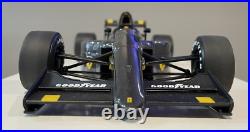
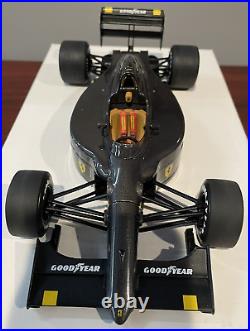
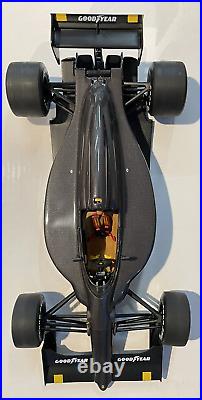
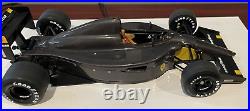
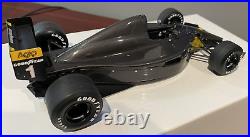
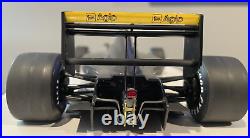
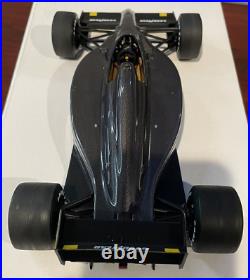

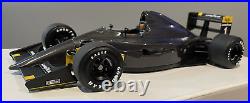
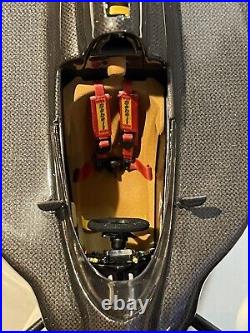
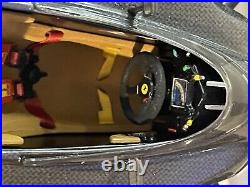
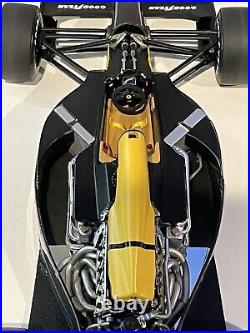
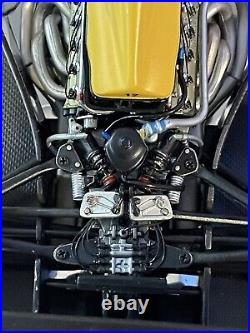
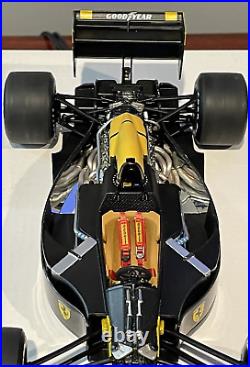
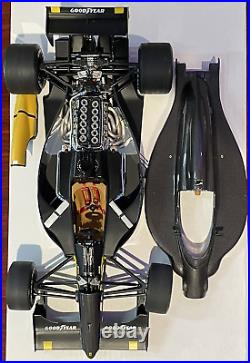
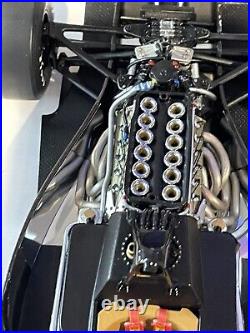
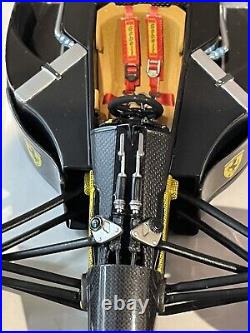
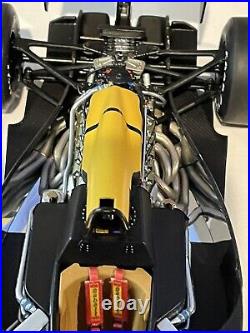
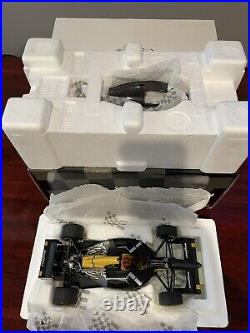
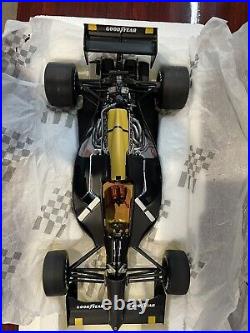
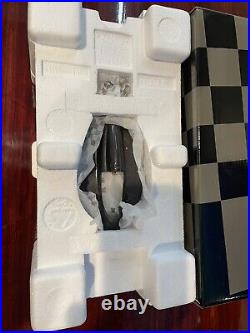
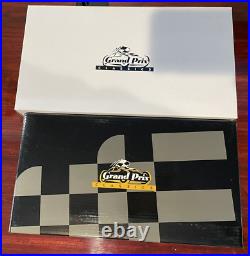

1990 Ferrari 641/2; Exoto Grand Prix Classics; 1:18 Scale. 1990 Formula 1, driven by Alain Prost, Carbon Fiber Test Car. Designed in 1:18 scale; 9.5 long. Superb carbon fiber; high gloss paint finish. Hand assembled with hundreds of scaled precision parts. Beautiful, rare, one of a kind and highly sought-after model. Never displayed or removed from box (only to take the photos for this listing). Special features include a removable cowling to showcase an unprecedented level of furious detail: fully wired and plumbed V12 engine coupled to individually cast exhaust headers, water and oil cooling radiators in photo-etch, fully detailed cockpit with suede-like covering on seat, fabric seat belts with photo-etched hardware, water pipes, hydraulic hoses, electrical wires, and much more.
Functioning features include: true-to-the-original suspension system with genuine coil springs and actuators, rotating brake discs, etc.. Engine bay features genuine aluminum heat shields, accurate pipes, hydraulic hoses, wires and more. Die-cast body with removable cowling. Water and oil radiators in photo-etch.
Rotating brake discs, front and rear. Fully wired and plumbed Ferrari V12 engine. Suspension system features genuine coil springs and actuators, front and rear. Removable airbox with suede-like seat and fabric seat belts with metal hardware.
Designed in 1:18 scale. Superb 11 step paint finish.
Hand assembled from over 200 precision scaled parts. The Ferrari 641 (also known as the Ferrari F1-90) was the Formula One racing car with which the Ferrari team competed in the 1990 Formula One World Championship. Driven by Alain Prost and Nigel Mansell, it won six Grands Prix. The 641 was a developed version of its predecessor, the 1989 Ferrari 640, designed by John Barnard. The updated 641 design was overseen by former McLaren designer Steve Nichols after Barnard left Ferrari to join the Benetton team, once the car's development was complete.
The car was powered by a 3.5-litre V12 engine, first with the type 036, and later in San Marino with the updated 037. The V12 was rated at 680 bhp (507 kW; 689 PS), only slightly down on the 690 bhp (515 kW; 700 PS) Honda V10 engines used by McLaren, but not as flexible or as good at delivering power out of slow corners as the Honda, the Renault V10 engine used by Williams or the Ford-Cosworth HB V8 used by Benetton. Prost declared it the best car of the year. The Ferrari 641 was also the first Formula One car to use an effective traction control system, which debuted at the 1990 Portuguese Grand Prix in Estoril; less than two years before a traction control system debuted on the eventually highly successful Williams FW14B.
Ferrari technicians sat down on the Tuesday after the Italian GP on September 11, and developed a rudimentary traction control system, which debuted in Portugal less than two weeks later. The system was relatively simple and straight-forward; using just some software and a wheel speed sensor.The car scored six wins in the 1990 season (Prost five wins, Mansell one). Incorporating the semi-automatic gearbox developed during the previous season, the car was seen to be technically advanced. The aerodynamics were reworked and the chassis gave a slightly longer wheelbase than its predecessor. Ferrari's major coup was signing reigning World Champion Alain Prost from McLaren to partner Nigel Mansell. As such, Nichols designed the car with Prost's smooth driving style in mind.
A variable inlet trumpet system on the engine was tested throughout the season but did not become standard equipment. Prost worked hard on improving the reliability of the gearbox and also worked behind the scenes to bring the whole Ferrari team closer together. Prost's development work helped the 641 chassis to be extremely fast and competitive, and he scored five wins, including a remarkable victory from 13th place on the grid in Mexico, and challenged his nemesis Ayrton Senna for the championship.In the same race, Mansell outfoxed Gerhard Berger with a daring passing move at the fearsome Peraltada corner. Although the car occasionally struggled in qualifying, it appeared to have the edge on the McLarens in race trim, particularly at high-speed circuits. At the British Grand Prix, Mansell dominated qualifying while Prost struggled. Feeling that Mansell's car was superior to his own, he convinced the team to switch the chassis before the race, which he won while Mansell retired and promptly announced his quitting the sport.
However, the famous collision between Prost and Senna at the Japanese Grand Prix sealed the Drivers' Championship for Senna and the Constructors' Championship for McLaren. Prost finished runner-up in the championship and Mansell finished 5th and scored 1 win, including excellent performance in his last race for Ferrari at Adelaide, where he finished 2nd and almost won that race from Nelson Piquet and his Benetton-Ford. It would be another seven years before Ferrari would challenge for either championship again. With two races left on the F1 calendar and 11 points separating them, Ferrari's Alain Prost and McLaren's Ayrton Senna were in the midst of a terrific battle for the Championship. Two races meant that 18 points were up for grabs, and both drivers knew that the situation was critical. Almost before the Grand Prix of Japan had started, the Championship outcome would be determined. Mirroring the events of the 1989 race at Suzuka in which Senna and Prost collided, securing Prost's Championship, in 1990 the pair again came together at the very first turn.This time, however, the Championship would go to Senna. Looking back at the events, qualifying for the race in Japan was a critical factor in the eventual outcome.
Saturday qualifying saw teams and drivers studying every nuance of their performances on the track, evaluating changes and making the most subtle adjustments, looking for that extra tenth that would gain them pole position. As early as Wednesday before the race Senna petitioned FISA officials to swap the pole position to the outside of the track, arguing that the polesitter should be on the best side of the circuit, as opposed to having the inside line for the first corner. When the green fell, Prost got off superbly and Senna spun his wheels on the dusty side of the track.It looked as if Senna would fall in line behind Prost, but made a sudden dive down the inside of Prost on onto the grass at the first turn. The season was over for the two drivers, but the war would go on for some years to come. This is truly a rare collector item.
For avid & passionate collectors. T hesitate to contact me with any questions; many thanks for the interest!